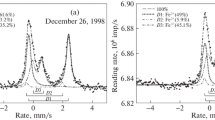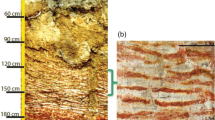Abstract
Ephemeral green rust is formed seasonally in some hydromorphic soils. It consists of Fe(II)/Fe(III) layered double hydroxides with different types of interlayer anions and different oxidation degrees of iron (x). In synthetized stoichiometric green rust, x = 0.25–0.33; in soil fougerite, it may reach 0.50–0.66. The mineral stability is provided by the partial substitution of Mg2+ for Fe2+. The ephemeral properties of the green rust are manifested in the high sensitivity to the varying redox regime in hydromorphic soils. Green rust disappears during oxidation stages, which complicates its diagnostics in soils. For green rust formation, excessively moist mineral soil needs organic matter as a source of energy for the vital activity of iron-reducing bacteria. In a gleyed Cambisol France, where fougerite is formed in the winter, the index of hydrogen partial pressure rH2 is 7.0–8.2, which corresponds to highly reducing conditions; upon the development of oxidation, fougerite is transformed into lepidocrocite. In the mineral siderite horizon of peatbogs in Belarus, where green rust is formed in the summer, rH2 is 11–14, which corresponds to the lower boundary of reducing conditions (rH2 = 10–18); magnetite is formed in these soils in the winter season upon dehydration of the soil mass.
Similar content being viewed by others
References
Yu. N. Vodyanitskii, “Artificial permeable redox barriers for purification of soil and ground water: a review of publications,” Eurasian Soil Sci. 47(10), 1058–1068 (2014).
Role of Supergene Iron Oxides in Geological Processes (Nauka, Moscow, 1975) [in Russian].
D. G. Zavarzina, Candidate’s Dissertation in Geological and Mineralogical Sciences (Moscow, 2001).
F. R. Zaidel’man, Gleyzation and Its Role in Soil Formation (Moscow State University, Moscow, 1998) [in Russian].
F. R. Zaidel’man, “Morphogleygenesis, its visual and analytic diagnostics,” Eurasian Soil Sci. 37(4), 333–340 (2004).
I. S. Kaurichev and D. S. Orlov, Oxidation-Reduction Processes in Their Role in Genesis and Fertility of Soils (Kolos, Moscow, 1982) [in Russian].
V. A. Kovalev, Boggy Mineral-Geochemical Systems (Nauka Tekhnika, Minsk, 1985) [in Russian].
K. I. Lukashev and V. A. Kovalev, “Some features of mineral-geochemical system of iron in modern peatlands,” Dokl. Akad. Nauk SSSR 187(6), 1390–1393 (1969).
The Encyclopedia of Mineralogy, Ed. by K. Frye (Springer-Verlag, London, 1982).
D. E. Pukhov, Candidate’s Dissertation in Biology (Moscow, 2002).
G. Sposito, The Thermodynamics of Soil Solutions (Clarendon Press, Oxford, 1981).
M. Abdelmoula, F. Trolard, G. Bourrie, and J.-M. R. Genin, “Evidence for the Fe(II)-Fe(III) green rust “fougerite” mineral occurrence in a hydromorphic soil and its transformation with depth,” Hyperfine Interact. 12, 235–238 (1998).
B. C. Christiansen, T. Balic-Zunic, P.-O. Petit, C. Frandsen, et al., “Composition and structure of an iron-bearing, layered double hydroxide (LDH) — green rust sodium sulphate,” Geochim. Cosmochim. Acta 73, 3579–3592 (2009).
D. G. Evans and R. C. T. Slade, “Structural aspects of layered double hydroxides,” Struct. Bond. 119, 1–87 (2006).
F. Feder, F. Trolard, G. Klingelhofer, and G. Bourrie, “In situ Mossbauer spectroscopy — evidence for green rust (fougerite) in gleysol and its mineralogical transformation with time and depth,” Geochim. Cosmochim. Acta 69, 4463–4483 (2005).
J. K. Fredrickson, J. M. Zachara, D. W. Kennedy, H. Dong, T. C. Onsolt, N. W. Hinmann, and S. Li, “Biogenic Fe mineralization accompanying the dissimilatory reduction of hydrous ferric oxide by a groundwater bacterium,” Geochim. Cosmochim. Acta 62, 3239–3257 (1998).
E. Fritsch, A. J. Herbillon, N. R. Nascimento, M. Grimaldi, and A. J. Melfi, “From plintic acrisols to plinthosols and gleysols: iron and groundwater dynamics in the tertiary sediments of the upper Amazon basin,” Eur. J. Soil Sci. 58, 989–1006 (2007).
J.-M. R. Genin, G. Bourrie, F. Trolard, M. Abdelmoula, A. Jaffrezic, Ph. Refai, V. Maitre, B. Humbert, and A. Herbillon, “Thermodynamic equilibrium in aqueous suspensions of synthetic and natural Fe(II)-Fe(III) green rusts: occurrences of the mineral in hydromorphic soils,” Environ. Sci. Technol. 32, 1058–1064 (1988).
J.-M. R. Genin, Ph. Refait, G. Bourrie, M. Abdelmoula, and F. Trolard, “Structure and stability of the Fe(II)-Fe(III) green rust “fougerite” mineral and its potential for reducing pollutants in soil solutions,” Appl. Geochem. 16(5), 559–570 (2001).
H. C. B. Hansen, O. K. Borggaard, and J. Sorensen, “Evaluation of the free energy of formation of iron(II)iron(III)-hydroxide-sulphate (green rust) and its reduction of nitrite,” Geochim. Cosmochim. Acta 58, 2599–2608 (1994).
R. S. Kukkadapu, J. M. Zachara, J. K. Fredrickson, and D. W. Kennedy, “Biotransformation of two-line ferrihydrite by dissimilatory Fe(III) reducing bacterium: formation of carbonate green-rust in presence of phosphate,” Geochim. Cosmochim. Acta 68, 2799–2924 (2006).
L. Legrand, L. Mazerolles, and A. Chausse, “The oxidation of carbonate green rust into ferric phases: solidstate reaction or transformation via solution,” Geochim. Cosmochim. Acta 68, 3497–3507 (2004).
D. G. Lewis, “Factors influencing the stability and properties of green rusts,” Adv. Geoecol. Reiskirhen 30, 345–372 (1997).
G. Ona-Nguema, M. Abdelmoula, F. Jorand, O. Behali, A. Genin, J.-C. Block, and J.-M. Genin, “Iron (II, III) hydroxycarbonate green rust formation and stabilization from lepidocrocite bioreduction,” Environ. Sci. Technol. 36, 16–20 (2002).
Ph. Refait, M. Abdelmoula, F. Trolard, J. M. R. Genin, J. J. Ehrhardt, and G. Bourrie, “Mossbauer and XAS study of green rust mineral: the partial substitution of Fe2+ by Mg2+,” Am. Miner. 86, 731–739 (2001).
Ph. Refait, A. Charton, and J.-M. R. Genin, “Identification, composition, thermodynamic and structural properties of a pyroaurite-like iron(II)-iron(III) hydroxyl-oxalate green rust,” Eur. J. Solid State Inorg. Chem. 35, 655–666 (1998).
E. E. Roden and M. M. Urrutia, “Influence of biogenic Fe(II) on bacterial crystalline Fe(III) oxide reduction,” Geomicrobiology J. 19, 209–251 (2002).
E. E. Roden, M. M. Urrutia, and C. J. Mann, “Bacterial reductive dissolution of crystalline Fe(II) oxide in continuous-flow column reactors,” Appl. Environ. Microbiol. 66, 1062–1065 (2000).
C. Ruby, C. Upadhyay, A. Genin, G. Ona-Nguema, and J.-M. R. Genin, “In situ redox flexibility of FeII-III oxyhydroxycarbonate green rust and fougerite,” Environ. Sci. Technol. 40, 4696–4702 (2006).
A. Sumoondur, I. Ahmed, and L. G. Benning, “Green rust as a precursor for magnetite: an in situ synchrotron based study,” Mineral. Mag. 72, 201–204 (2008).
R. M. Taylor, “Formation and properties of Fe(II)Fe(III) hydroxy-carbonate and its possible significance in soil formation,” Clay Miner. 15, 369–382 (1980).
F. Trolard and G. Bourrie, “Fougerite a natural layered double hydroxide in gley soil: habitus, structure, and some properties,” Clay Miner. Nat., Ch. 9, 171–188 (2012).
F. Trolard and G. Bourrie, “Geochemistry of green rusts and fougerite: a reevaluation of Fe cycle in soils,” Adv. Agron. 99, Ch. 5, 227–287 (2008).
F. Trolard and G. Bourrie, “Structure of fougerite and rusts and thermodynamic model for their stabilities,” J. Geochem. Explor. 88, 249–251 (2006).
F. Trolard, G. Bourrie, E. Jeanroy, A. J. Herbillon, and H. Martin, “Trace metals in natural iron oxides from laterites: a study using selective kinetic extraction,” Geochim. Cosmochim. Acta 59, 1285–1297 (1995).
M. Usman, K. Hanna, M. Abdelmoula, A. Zegeye, P. Faure, and C. Ruby, “Formation of green rust via mineralogical transformation of ferric oxides (ferrihydrite, goethite and hematite),” Appl. Clay Miner. 64, 38–43 (2012).
World Reference Base for Soil Resources (Wageningen, 1998), No. 84.
A. Zegeye, C. Mustin, and F. Jorand, “Bacterial and iron oxide aggregation mediate secondary iron mineral formation: green rust versus magnetite,” Geobiology 8, 209–222 (2010).
Author information
Authors and Affiliations
Corresponding author
Additional information
Original Russian Text © Yu.N. Vodyanitskii, S.A. Shoba, 2015, published in Pochvovedenie, 2015, No. 3, pp. 277–287.
Rights and permissions
About this article
Cite this article
Vodyanitskii, Y.N., Shoba, S.A. Ephemeral Fe(II)/Fe(III) layered double hydroxides in hydromorphic soils: A review. Eurasian Soil Sc. 48, 240–249 (2015). https://doi.org/10.1134/S106422931503014X
Received:
Published:
Issue Date:
DOI: https://doi.org/10.1134/S106422931503014X




